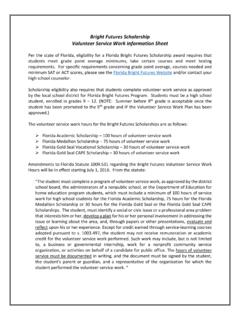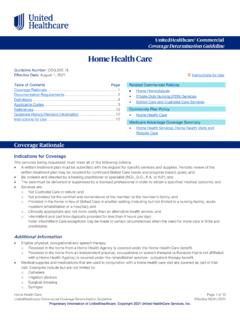Transcription of THE FOODSERVICE INDUSTRY™S GUIDE TO COOK-CHILL
1 THE FOODSERVICE INDUSTRY S GUIDETO COOK-CHILLBYVICTORY Cook/chill is a simple, controlled system of food preparation designed to provide more flexibility in food service. Thetechnique involves the full cooking of food, followed by rapid chilling and storage at controlled temperatures (for up to fivedays). When required, the food must be reheated thoroughly before service. The production system itself is simple tooperate if well managed, and completely safe provided the HACCP (Hazard Analysis and Critical Control Point) Guidelineson temperature control are uses cook/chill?Thousands of establishments of all types and sizes currently use cook/chillsystems. Anyone who has eaten at a top restaurant or hotel, at a banquet orreception, or on an airplane or ship is likely to have eaten a cook/chill my business benefit from cook/chill?While cook/chill is commonly associated with larger institutional foodserviceoperations, new compact quick chill equipment designs have put quick chillsystems within the realm of all types and sizes of FOODSERVICE operations.
2 HOTELS ! RESTAURANTS ! FAST FOOD RESTAURANTS ! HOSPITALS/ NURSING HOMES ! CONTRACT CATERERS ! BAKERYS ! CORPORATECAFETERIAS ! INSTITUTIONAL CATERERS ! CAFE/BISTROS ! TRAVELCATERERS ! meals ON WHEELS ! PIZZERIAS ! IN-FLIGHT CATERINGFor large and small establishments the principles and advantages of the system are thesame. The only difference is that small to medium sized operations do not have to investin equipment design to deal with the simplest cook/chill system, all that is required in addition to the existing cookingequipment is a blast chiller, adequate cold storage and an understanding of therecommended safety do FOODSERVICE establishments use blast chillers?The principle feature of blast chillers and blast freezers is that they are capable of rapidly reducing the temperature of hotfoods to low, safe temperatures (see page 6). Therefore, they make it easier for FOODSERVICE establishments to comply withFood Safety and Temperature Control legislation.
3 In fact, many establishments are using them solely for that purpose, andin doing so are actually performing a very basic cook/chill operation. Using a blast chiller solely to cool cooked food rapidlyfor immediate or same day service is not utilizing all the benefits that a blast chiller can potentially offer. How quickly will I be able to recover my investment?Naturally, business with a large meal turnover will recover the capital cost of the equipment veryrapidly. However, small business can also immediately recover the capital cost of theequipment as they can immediately recover a proportion of their labor costs. The resultingefficiency and increased capacity pave the way for increased meal turnover, therebyaccelerating the cost recovery IIS CCOOK/CHILL?By utilizing cook/chill technology, meals can be prepared, cooked, chilled and rethermalized with little or no nutritional lossand without altering its appearance, or are several misconceptions concerning cook/chill:Myth - Cook/chill is only for large is not: Many nursing homes, function caterers, hotels, independent restaurants, fast foodrestaurants and bakers are already reaping the positive benefits of the cook/chill - Cook/chill requires special true: You can use most of your favorite recipes without adaptation.
4 What s more, youcan try out new and more exotic ideas because blast chillers give you more time allowing youto store meals for up to five - The equipment is large and necessarily: The equipment required by hospitals, prisons and schools, which producelarge volumes of food, is large and can therefore be costly. But this is not the case for smallor medium sized establishments. Many of these operators will already have suitable ovensand storage facilities, so they will only need to acquire a blast chiller. A chiller capable ofhandling over 250 meals a day can be purchased for about twice the price of a reach-in - Cook/chill limits the professional the contrary: Cook/chill allows you more time to utilize creative skills than any other method. Instead of spendingvaluable time on boring tasks, the professional operator can use that time to improve presentation, create new dishes andattend to all the other detail that makes a successful FOODSERVICE Systems are:!
5 Simple to operate,!profitable,!time saving,!productive,!flexibleMost importantly, blast chill technology can improve time saving and make it easier for operations to comply with foodquality regulations. THE TTRUTH BBEHIND CCOOK/CHILLS uitable for most FOODSERVICE operationsThe system can be utilized effectively by establishments of any size or time managementThe system allows FOODSERVICE establishments to better organize their time. Primecooking can take place when the business is quiet, leaving less to do when you havecustomers to attend resource managementEquipment can be used more energy efficiently while ingredients can be bought in largerquantities, providing economies of scale. You can also prepare meals for severalestablishments from one extensionThe flexibility of the system allows you to prepare a greater selection of dishes, offering your customers more choice whilestill maintaining or improving quality.
6 In addition, since you are preparing meals in advance you can afford to experimenton a variety of different modification of recipesA cook/chill system allows you to use most recipes without in serviceBecause most food will be prepared in advance, the FOODSERVICE operator will have moretime to improve on presentation and attend to in serviceBecause all dishes simply have to be reheated before service, operators can serve a widevariety of food all day and can easily cope with the fluctuating numbers of customersthroughout the waste and improved portion controlPortions can be made up precisely and meals can be rethermalized as needed, profitabilityCook/Chill can make your operation more efficient while offering customers greater choiceand better service. You will be able to cope with larger numbers of customers and at shortnotice. This will result in increased turnover and profitability.
7 Fantastic opportunity for expansionIf the meal turnover of your business is limited by the number of meals you are presently able to cook and serve, cook/chillis a fast way to increase your capacity without necessarily expanding your kitchen or employing extra OOF CCOOK/CHILLWhat you will needIf you are already serving hot food, the only additional equipment you will require for a small to medium sized cook/chilloperation is an appropriately sized blast chiller. You will also need a suitable reach-in or walk-in refrigerator for the storageof finished with any cooking operation, a cook/chill system requires care to ensure that food does not become exposed to harmfulbacteria. Staff should, therefore, be given specific training on the cook/chill operation, in addition to basic food hygienetraining. Your equipment supplier should be able to help you with is easiest to view a cook/chill system as a series of stages.
8 Each of these should be regarded as equally important toguarantee food safety, and good quality of raw of raw of chilled of chilled foods (if applicable) of Selection of raw materialsIf raw materials are below standard when you buy them, they are not going to improve with cooking. It is vital, therefore,that you check your supplies and, if necessary, check on your suppliers handling and distribution Storage of raw materialsHaving purchased top quality raw materials, it makes sense to keep them in properstorage and in top condition before they are needed. This means following basicfood safety principles, to ensure that the appropriate temperature and humiditylevels are PreparationAgain, basic food safety principles apply. Separate surfaces and separate utensilsshould be used for the preparation of raw fish, meat and poultry to prevent , food preparation should take place in an area separate from the cooking andpost SSYSTEMHOW IIT WWORKS If some raw materials arrive in a frozen condition, they should be thoroughly thawed out before use.
9 We recommend a Victory controlled thawing cabinet for this purpose. Rapid high temperature thawing can encourage the growth ofpathogens and may leave cold spots at the core of the food. For this reason we do not recommend thawing products witha microwave oven unless the oven is specifically designed to ensure order to make chilling more efficient after cooking, beef or packs of meat should not weigh more than lbs, or measuremore than 4 in CookingWhatever the food product you are cooking and by whatever method, it is essential that the core temperature of the foodreaches at least 160 F, and is held at this temperature for at least two minutes. This is to ensure that any pathogenic micro-organisms that may be present are destroyed. To check the core temperature of food use a probe thermometer. (Checkthe accuracy of this and any other thermometers used, every three months).
10 You will not find it necessary to modify your usual recipes for a cook/chill PortioningOnce the food is cooked, the chilling process must start as soon as possible, and at most within thirty minutes. This leavestime for portioning prior to chilling. However, handling of food should be kept to a minimum. meals can be portioned fromindividual components after chilling. Usually, the ideal containers for chilling food should be no more than 2 1/2 containers may only be used if the blast chiller is capable of chilling the food to the required temperature in therequired time. Note also that some containers are made of materials which can insulate the food, thereby affecting disposable containers are used, it is essential that they have been stored under proper hygienic Rapid ChillingWhatever the type of blast chiller you use, it should be capable of chilling the foodbetween 33 F and 38 F within 2 to 4 hours of placing the hot food in the blast chiller andcommencing the blast chill cycle.





